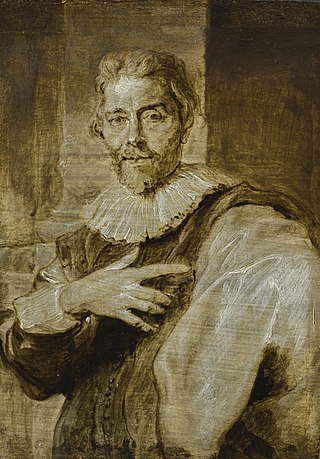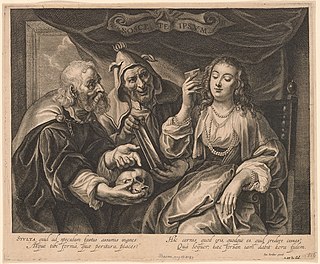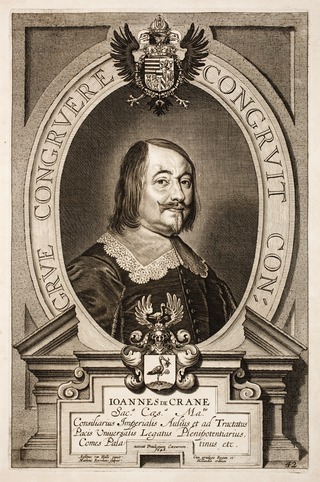
Philip Fruytiers (1610–1666) was a Flemish Baroque painter and engraver. Until the 1960s, he was especially known for his miniature portraits in watercolor and gouache. Since then, several large canvases signed with the monogram PHF have been ascribed to him. These new findings have led to a renewed appreciation for his contribution to the Antwerp Baroque.

Abraham van Diepenbeeck was Dutch painter, draftsman, glass painter, print maker and tapestry designer who worked most of his active career in Antwerp. He designed glass windows for various churches and monasteries in Antwerp for which he made many design drawings and oil sketches. He engraved and designed many prints which were published by prominent Antwerp printers such as van Meurs, the Plantin Press and Martinus van den Enden the Elder. He had a close relationship with the workshop of the leading Flemish Baroque painter Peter Paul Rubens and collaborated on various projects under the direction of Rubens. In the 1630s van Diepenbeeck started to create monumental paintings. His work was influenced by Rubens and Anthony van Dyck.

Lucas Vorsterman (1595–1675) was a Baroque engraver. He worked with the artists Peter Paul Rubens and Anthony van Dyck, as well as for patrons such as Thomas Howard, 21st Earl of Arundel and Charles I of England.

Cornelis Schut was a Flemish painter, draughtsman, engraver and tapestry designer who specialized in religious and mythological scenes. Presumed to have trained under Rubens, he treated Counter-Reformation subjects in a High-Baroque style. After a stay in Italy, he worked mainly in Antwerp where he was one of the leading history painters in the first half of the 17th century.

Jan Wildens was a Flemish painter and draughtsman specializing in landscapes. His Realist landscapes show an eye for detail and have a serene character. He was a regular collaborator with Rubens and other leading Flemish Baroque painters of his generation in whose compositions he painted the landscapes.

Jan Thomas or Jan Thomas van Ieperen was a Flemish Baroque painter, draughtsman and printmaker. He was first active in Antwerp where he worked in the workshop of Rubens. He later became court painter at the Habsburg court in Vienna. He is known for his portraits of the rulers of Austria as well as for his pastoral, mythological and religious scenes.

Sir Peter Paul Rubens was a Flemish artist and diplomat. He is considered the most influential artist of the Flemish Baroque tradition. Rubens's highly charged compositions reference erudite aspects of classical and Christian history. His unique and immensely popular Baroque style emphasised movement, colour, and sensuality, which followed the immediate, dramatic artistic style promoted in the Counter-Reformation. Rubens was a painter producing altarpieces, portraits, landscapes, and history paintings of mythological and allegorical subjects. He was also a prolific designer of cartoons for the Flemish tapestry workshops and of frontispieces for the publishers in Antwerp.
Boetius à Bolswert was a Flemish engraver of Friesland origin. In his time the paintings of Peter Paul Rubens called forth new endeavours by engravers to imitate or reproduce the breadth, density of mass and dynamic illumination of those works. Boetius Bolswert was an important figure in this movement, not least because he was the elder brother and instructor of the engraver Schelte à Bolswert, whose reproductions of Rubens's landscapes were most highly esteemed in their own right.

Pieter de Jode II or Pieter de Jode the Younger (1606–1674) was a Flemish Baroque printmaker, draughtsman, painter and art dealer. A scion of an important dynasty of printmakers active in Antwerp, he created many prints after the works of leading painters and was a close collaborator of Anthony van Dyck for whom he engraved many portraits.

Jan Baptist Barbé or Jan-Baptist Barbé (1578–1649) was a Flemish engraver, publisher and art dealer active in Antwerp. He is known for his engravings after his own designs as well as for his reproductive engravings.

Paulus Pontius was a Flemish engraver and painter. He was one of the leading engravers connected with the workshop of Peter Paul Rubens. After Rubens' death, Pontus worked with other leading Antwerp painters such as Anthony van Dyck and Jacob Jordaens.

Coenraed Lauwers or Coenraad Lauwers, latinized as Coenradus Lauwers(1632 in Antwerp – 1685 in Antwerp) was a Flemish engraver, etcher and print seller. He was mainly active as a reproducer of works of leading Antwerp painters.

Jacob Neefs or Jacob Neeffs was a Flemish etcher, engraver and publisher. He worked on publication projects for prominent Flemish artists of his time including Rubens, van Dyck and Jacob Jordaens.

Marinus Robyn van der Goes or Marinus van der Goes was a Flemish engraver. He was active as a reproductive engraver after the works of Flemish and Dutch designers.

Antoon van der Does or Antoni van der Does was a Flemish engraver and print maker who was active in Antwerp. He is mainly known as a reproductive artist.

Lucas Vorsterman II, Lucas Vorsterman the Younger or Lucas Vorsterman Junior was a Flemish Baroque engraver and draughtsman. He produced engravings after the work of the leading painters of the next generation and for the various book projects of the Antwerp publishers.

Abraham Teniers was a Flemish painter and engraver who specialized in genre paintings of villages, inns and monkey scenes. He was a member of artist family Teniers which came to prominence in the 17th century. He was also active as a publisher.

Alexander Voet the Elder or Alexander Voet I was a Flemish engraver, print artist and publisher. He was one of the leading engravers and publishers in Antwerp in the middle and second half of the 17th century. He operated a large workshop in which sixty to seventy collaborators took care of the entire process of printmaking, printing and publishing.

Mattheus Borrekens or Mattheus Borkens was a Flemish engraver, printmaker and draughtsman. He was a reproductive artist and worked on some important publications in the Southern Netherlands. He mainly treated Christian religious subjects and portraits.

Nicolaas van der Horst or Nicolaus van der Horst was a Flemish painter, draughtsman and tapestry designer. He was courtier at the court of the governors of the Habsburg Netherlands in Brussels and given the title of Archer de la Garde. He also was a cartographer. He is now known less for his paintings than for his designs for prints published by the Antwerp printers.





















